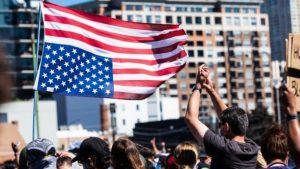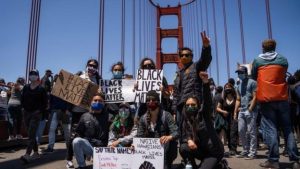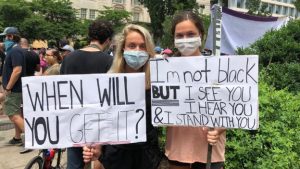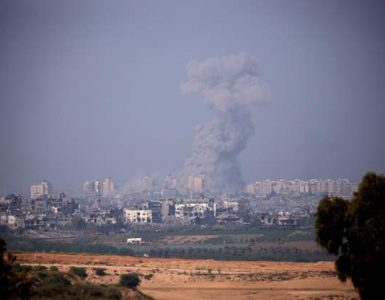Huge peaceful rallies have taken place across the US against racism and police brutality on the 12th day of protests sparked by George Floyd’s death.
Tens of thousands of people marched in Washington DC, in the city’s largest protest so far. Security forces blocked any approach to the White House.
Crowds also demonstrated in New York, Chicago and San Francisco.
Meanwhile, people paid their respects to Mr Floyd in North Carolina, where he was born, before a memorial service.
Mr Floyd, an unarmed black man, died in police custody in Minneapolis on 25 May. Video showed a white police officer, Derek Chauvin, kneeling on Mr Floyd’s neck for almost nine minutes while he is pinned to the floor.
Mr Chauvin has been dismissed and charged with murder. Three other officers who were on the scene have also been sacked and charged with aiding and abetting.
- In pictures: Protests in US and around the world
- Why I decided not to watch Floyd’s video
- Timeline: From Kaepernick kneeling to NFL apology
Large anti-racism protests also took place in a number of other countries. In the UK, Parliament Square in central London was filled with people despite calls by the government to avoid mass gatherings for fear of spreading the coronavirus.
In Australia, there were major protests in the cities of Sydney, Melbourne and Brisbane that focused on the treatment of indigenous Australians. There were also demonstrations in France, Germany and Spain.
What happened at the protests?
In the US capital, protesters – many of them carrying placards saying “Black Lives Matter” – gathered peacefully near the Capitol, the Lincoln Memorial and outside Lafayette Park, next to the White House, at the newly renamed Black Lives Matter Plaza.
Mayor Muriel Bowser welcomed people, saying the crowds had sent a message to President Donald Trump. On Monday, federal law enforcement officers fired tear gas to clear a protest in the area ahead of a visit to a church by the president.

“If he can take over Washington DC, he can come for any state, and none of us will be safe,” she said. “Our soldiers should not be treated that way, they should not be asked to move on American citizens.”
Ms Bowser has requested the withdrawal of all federal law enforcement officers and National Guard troops from the city, saying their presence is “unnecessary”.
A 35-year-old protester, Eric Wood, told the BBC: “I’m here because I really couldn’t afford not to be here. Racism has long been a part of the US.”
Crystal Ballinger, 46, said she felt hopeful about the movement this time. “I feel something different about this protest… I’m hopeful that the message of solidarity and equality is getting out.”
In New York, crowds crossed the Brooklyn Bridge, while in San Francisco demonstrators briefly shut the Golden Gate Bridge. In Chicago, about 30,000 people rallied in Union Park, and a Hollywood intersection was blocked by protesters in Los Angeles.
In Seattle, a number of healthcare workers – many in uniforms – marched to the City Hall. And in Richmond, Virginia, a statue of a Confederate general was pulled down from its pedestal.
There were also protests in Atlanta and Philadelphia, where crowds chanted “We need justice, we need love”.
Meanwhile, the top editor of The Philadelphia Inquirer resigned after publishing a headline which equated property damage to the deaths of black people, which prompted public condemnation from many of the newspaper’s staff.
Stan Wischnowski apologised for what he described as a “horribly wrong” decision to use the headline “Buildings Matter Too” on an article about civil unrest in the US.

‘We’re just getting started’
By Helier Cheung, BBC News, Washington DC
The crowd was diverse – with people of different ethnicities, and families with children – and there was an upbeat, if determined, mood. Music was being played and food, water and hand sanitiser handed out, as protesters chant “George Floyd”, “Breonna Taylor” – who also died in police custody, in March – and “No justice, no peace”.
The protest’s movements appeared quite spontaneous. At one point, demonstrators did an impromptu march through the streets, walking down Pennsylvania Avenue before looping back towards the White House. At another, the entire street of demonstrators dropped on one knee at the same time, in a mark of solidarity.
Sisters Sarina Lecroy, 20, and Grace, 16, said they were protesting for the first time, and that they believed the extent of the public outrage and the nationwide nature of these protests could lead to police reforms. “We’re just getting started this time, but it [the movement] does feel much more collective than in the past,” said Sarina.
Many placards also reflected the growing debate about how white people should help the cause. One placard held by a demonstrator read: “I may never understand, but I will stand with you.

What do protesters want?
On social media and on the streets, those in support of the movement have called on elected officials to address longstanding systemic racism and inequalities, from police brutality to mass incarceration to healthcare.
Black Americans are jailed at five times the rate of white Americans and sentenced for drug offences six times more, often despite equal rates of drug use, according to the National Association for the Advancement of Colored People (NAACP).
What do protesters want?
On social media and on the streets, those in support of the movement have called on elected officials to address longstanding systemic racism and inequalities, from police brutality to mass incarceration to healthcare.
Black Americans are jailed at five times the rate of white Americans and sentenced for drug offences six times more, often despite equal rates of drug use, according to the National Association for the Advancement of Colored People (NAACP).



 Buy Steroids Online
Buy Steroids Online



Add comment